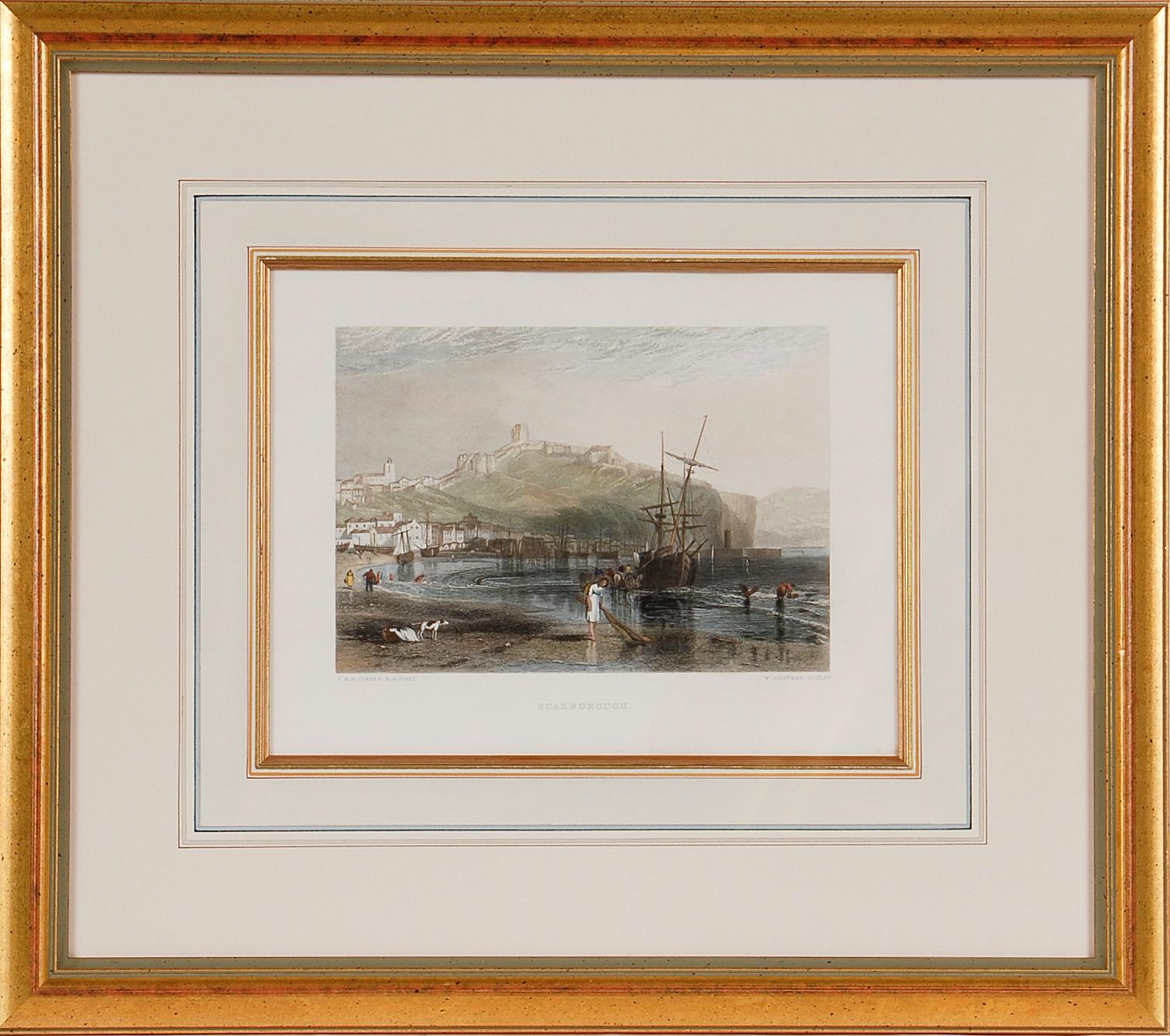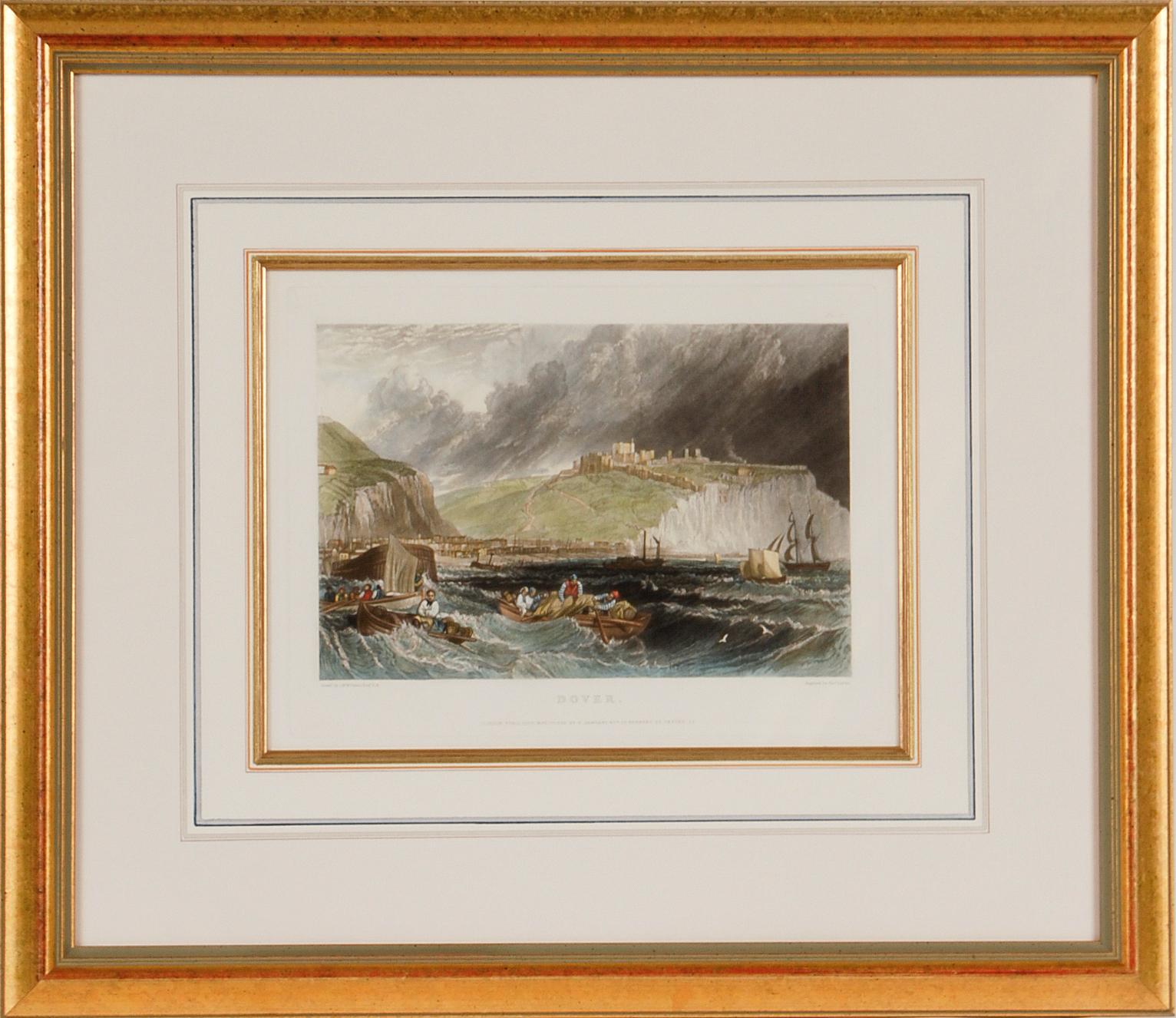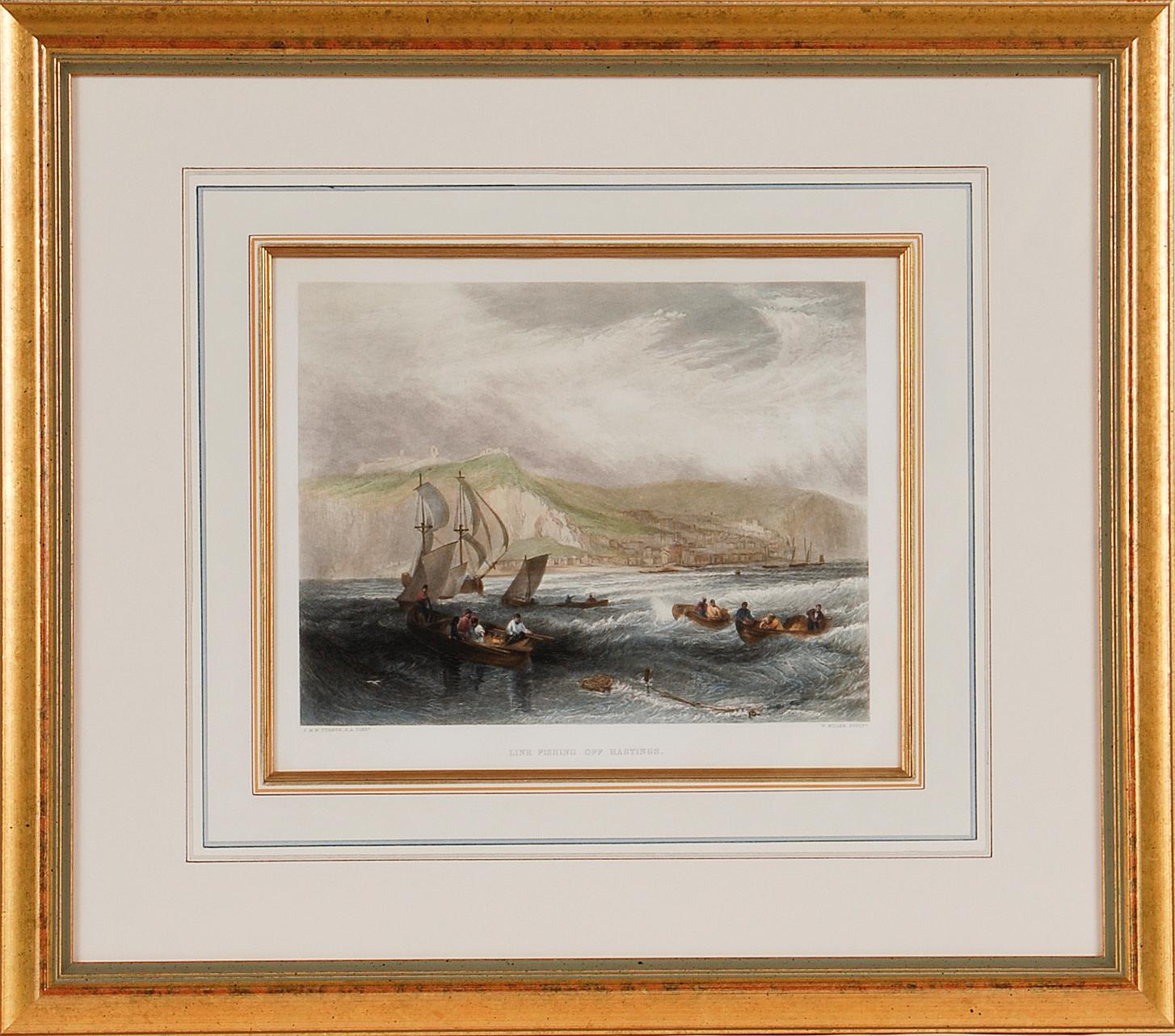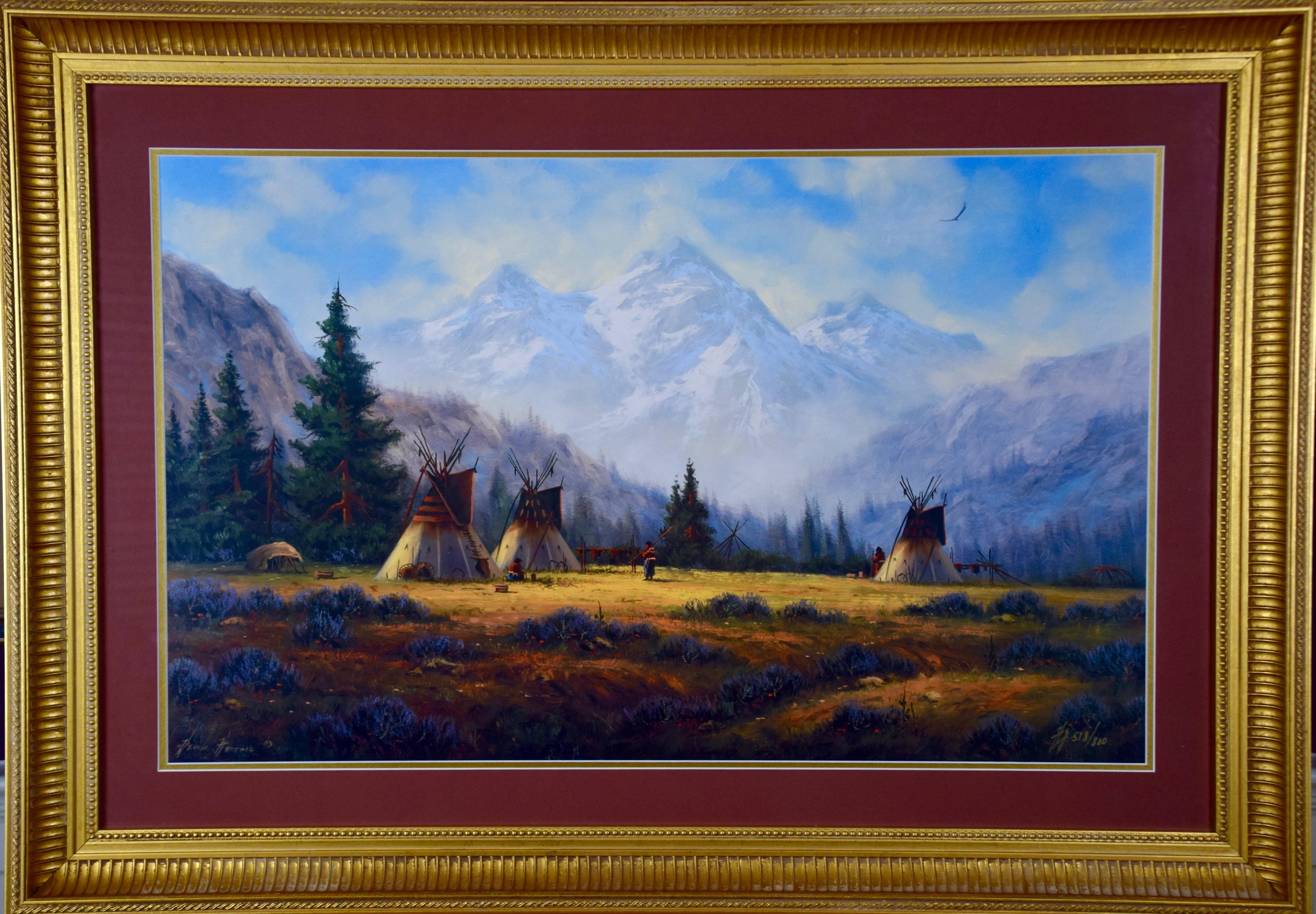Items Similar to Ulysses Deriding Polyphemus: A Framed 19th C. Engraving After J. M. W. Turner
Want more images or videos?
Request additional images or videos from the seller
1 of 8
Ulysses Deriding Polyphemus: A Framed 19th C. Engraving After J. M. W. Turner1859
1859
About the Item
This beautiful 19th century framed hand-colored engraving/etching entitled "Ullyses Deriding Polyphemus" by Edward Goodall is based on an original 1829 painting by the renowned British artist J.M.W. Turner. It was published by James S. Virtue & Co. in London between 1859-1875. It depicts a dramatic scene from Greek mythology, specifically from Homer's epic poem "The Odyssey." In the story, the hero Ulysses (or Odysseus) and his men find themselves trapped inside the cave of the Cyclops Polyphemus, who is known for having only one eye. Ulysses, in an attempt to save his crew, devises a plan to blind the Cyclops and escape. He does so by offering the Cyclops wine and, when he is inebriated, driving a burning stake into his single eye. Turner's engraving captures the climactic moment of the story, as Ulysses and his companions are shown sailing away from the cave in a small boat. Ulysses, depicted as a tiny figure on the boat, can be seen raising a cup in a mocking gesture towards the enraged Polyphemus, who stands on the shore, raising his arms in frustration and pain. The scene is set against a tumultuous seascape, with dark and swirling waves and a stormy sky, adding to the dramatic intensity of the composition.
"Ulysses Deriding Polyphemus" exemplifies Turner's ability to capture the power of nature and the human drama within his artworks. It showcases his skillful use of light, shadow, and atmospheric effects to create a sense of awe-inspiring beauty and emotional intensity. The engraving remains an important example of Turner's artistic legacy and his contribution to the Romantic movement in art.The Goodall engraving of "Ulysses Deriding Polyphemus" after Turner captures the dramatic tension and mythological significance of this encounter. It showcases Ulysses' bravery and quick thinking, while also highlighting the monstrous nature of Polyphemus. The artwork serves as a testament to the enduring appeal of classical mythology and Turner's skill as a painter, as well as the talent of Goodall as an engraver in faithfully translating the original work into a different medium.
This colorful 19th century engraving is presented in a gold-colored wood frame and double cream-colored mats. The frame measures 13.88" high, 27.25" wide and 1.5" deep. The engraving, frame and mat are in excellent condition.
This engraving is held by several museums and institutions, including: The British Museum, The Metropolitan Museum. The Tate Museum, The Victoria and Albert Museum, The Yale Center for British Art, The Fine Arts Museums of San Francisco, and The Museum of Fine Arts Boston.
Joseph Mallord William (J.M.W.) Turner (1775-1851) was an English painter who is widely considered one of the greatest landscape painters in Western art history. Born in London, he showed a remarkable talent for art from a young age, and studied at the Royal Academy of Arts from the age of 14. He quickly gained recognition for his watercolor landscapes, which were highly innovative and expressive. Turner's style evolved over time, and he became increasingly interested in the effects of light and color. He traveled extensively throughout Europe, and his experiences of the natural world, particularly the sea and the sky, had a profound influence on his art. His paintings are known for their luminosity, atmospheric effects, and dramatic use of color. Despite facing criticism and ridicule from some of his contemporaries, Turner continued to push the boundaries of art, experimenting with new techniques and styles throughout his career. He was a prolific artist, creating thousands of paintings, sketches, and watercolors, and his legacy continues to inspire artists today.
Edward Goodall (1795-1870) was a renowned English landscape and portrait painter, widely recognized for his exceptional talent and meticulous attention to detail. Goodall's interest in landscapes eventually extended to portraiture, and he gained recognition for his ability to depict the unique character and expressions of his subjects. His portraits possessed a remarkable depth and realism, capturing not just physical appearances but also the inner emotions and personalities of the individuals he painted. In addition to his prowess as a painter, Goodall was also an accomplished etcher, engraver, and illustrator. His works were often featured in prominent publications of the time, including illustrated books and periodicals. His intricate engravings showcased his exceptional technical skill and contributed to the dissemination of his artistic vision to a wider audience.
Edward Goodall's talent and dedication earned him considerable acclaim during his lifetime. He exhibited his works at the Royal Academy and other prestigious art institutions, garnering praise for his exceptional technique and artistic sensibility. His contributions to the art world were also recognized through his appointment as a member of the Royal Society of Painters and Etchers. Today, Goodall's paintings and engravings continue to be cherished for their beauty and historical significance. They provide a window into the landscapes and society of the 19th century, capturing a fleeting moment in time with remarkable skill and artistry.
- Creation Year:1859
- Dimensions:Height: 13.88 in (35.26 cm)Width: 17.25 in (43.82 cm)Depth: 1.5 in (3.81 cm)
- Medium:
- Movement & Style:
- After:J.M.W. Turner (1775 - 1851, British)
- Period:
- Condition:
- Gallery Location:Alamo, CA
- Reference Number:
About the Seller
5.0
Platinum Seller
These expertly vetted sellers are 1stDibs' most experienced sellers and are rated highest by our customers.
Established in 2011
1stDibs seller since 2019
233 sales on 1stDibs
Typical response time: 1 hour
- ShippingRetrieving quote...Ships From: Alamo, CA
- Return PolicyA return for this item may be initiated within 7 days of delivery.
More From This SellerView All
- A View of Scarborough, England: A Framed 19th C. Engraving After J. M. W. TurnerBy J.M.W. TurnerLocated in Alamo, CAThis beautiful 19th century framed engraving "Scarborough" by W. Chapman is based on an original painting by the renowned British artist J.M.W. Turner. It was published in London by ...Category
Mid-19th Century Romantic Landscape Prints
MaterialsEngraving
- The Fighting Temeraire: A Framed 19th C. Engraving After J. M. W. TurnerBy J.M.W. TurnerLocated in Alamo, CAThis beautiful 19th century framed engraving "The Fighting Temeraire" by James Tibbetts Willmore is based on an original painting by the renowned British artist J.M.W. Turner. It was published by James S. Virtue & Co. in London between 1859-1875. It depicts the once mighty British warship the HMS Temeraire being towed away down the river Thames by a much smaller steamboat to a ship-breaking yard to be broken up for scrap. The Temeraire was first launched in 1798 and represented the pinnacle of British ship-building. 180-feet long, constructed of English oak and armed with 98 guns, she was one of the largest warships of the period. The Temeraire became a symbol of British pride and military power that endured throughout the 19th century. The man-of-war served during the French Revolutionary and Napoleonic Wars and was among the last serving ships to have been at the Battle of Trafalgar in 1805. It became one of the many older ships put out of service in the 1830s and 1840s. The once mighty and feared ship symbolizes a once magnificent, but now obsolete, technology. Turner seems to lament her inglorious final journey, being towed by a less magnificent, but modern steam powered tugboat. The Turner painting was created in 1838 and is now held in the National Gallery in London. Willmore's engraving, created in 1859, captures the dramatic scene with great detail and skill. The image has become an iconic representation of the decline of Britain's naval power and the transition from sail to steam in the 19th century. The sunset in the background is symbolic of the sun going down on British naval power and tradition. The painting conveys profound and diverse themes that are central to the human experience: those of mortality and change, technology and progress, heroism and brutality. The painting demonstrates Turner’s skill as an artist. His ability to produce scenes of great beauty that are dramatic, but are also symbolic, stimulating both thoughtful analysis, as well as emotion. Turner's painting was voted by the British public in a 2005 BBC radio sponsored survey to be the British people's favorite painting of all time. In 2020 it was included on a new British banknote...Category
Mid-19th Century Romantic Landscape Prints
MaterialsEngraving
- St. Michael's Mount, Cornwall: A Framed 19th C. Engraving After Myles FosterBy Myles Birket FosterLocated in Alamo, CAThis beautiful 19th century framed hand-colored engraving is entitled "St. Michael's Mount, Cornwall" by J. Saddler after an original painting by the British artist Myles Birket Fost...Category
Mid-19th Century Romantic Landscape Prints
MaterialsEngraving
- A View of Dover, England: A Framed 19th C. Engraving After J. M. W. TurnerBy J.M.W. TurnerLocated in Alamo, CAThis beautiful 19th century framed engraving "Dover" by Thomas Lupton is based on an original painting by the renowned British artist J.M.W. Turner, which depicts a panoramic view of the harbor of Dover, a town in southeastern England, that has been an important port for centuries. The engraving captures the dramatic sky and sea that Turner was known for, with billowing clouds and waves crashing against the shore. The town and its famous white cliffs are visible in the background, while ships and boats dot the harbor in the foreground. Several wooden rowboats...Category
Mid-19th Century Romantic Landscape Prints
MaterialsEngraving
- Fishing Off Hastings, England: A Framed 19th C. Engraving After J. M. W. TurnerBy J.M.W. TurnerLocated in Alamo, CAThis beautiful 19th century framed engraving "Line Fishing Off Hastings" by William Miller is based on an original painting by the renowned British artist J.M.W. Turner, which depicts a scene of fishermen at work off the coast of the town of Hastings in East Sussex, England. The Miller engraving faithfully reproduces Turner's painting, capturing the same atmospheric quality and sense of motion. In the foreground of the image, a group of fishermen are shown in a small boat, with one man using a fishing line to catch fish. In the background, there is a larger ship, along with a view of the town of Hastings and the cliffs beyond. Overall, the Miller engraving "Line Fishing Off Hastings" is a beautiful and detailed representation of Turner's original painting, and provides a glimpse into life in a 19th century fishing community. This colorful 19th century engraving is presented in a gold-colored wood frame and a cream-colored French mat highlighted with a light blue band and thinner mustard and gold-colored bands. There is a gold-colored fillet which further embellishes the engraving. The frame measures 18" high, 20.5" wide and 1" deep. The engraving, frame and mat are in excellent condition. Joseph Mallord William (J.M.W.) Turner (1775-1851) was an English painter who is widely considered one of the greatest landscape painters in Western art history. Born in London, he showed a remarkable talent for art from a young age, and studied at the Royal Academy of Arts from the age of 14. He quickly gained recognition for his watercolor landscapes, which were highly innovative and expressive. Turner's style evolved over time, and he became increasingly interested in the effects of light and color. He traveled extensively throughout Europe, and his experiences of the natural world, particularly the sea and the sky, had a profound influence on his art. His paintings are known for their luminosity, atmospheric effects, and dramatic use of color. Despite facing criticism and ridicule from some of his contemporaries, Turner continued to push the boundaries of art, experimenting with new techniques and styles throughout his career. He was a prolific artist, creating thousands of paintings, sketches, and watercolors, and his legacy continues to inspire artists today. William Miller (1796-1882) was an English engraver and publisher, best known for his work in reproducing the paintings of J.M.W. Turner. Miller was born in Bristol and began his career as an engraver at a young age, working for a variety of publications and artists. In the early 1820s, Miller began working with Turner, engraving many of the artist's most famous works, including "The Fighting Temeraire...Category
Mid-19th Century Romantic Landscape Prints
MaterialsEngraving
- Native American Encampment in a Valley, Limited Edition Hartwig Signed PrintBy Heine HartwigLocated in Alamo, CAThis is a limited edition print from a painting by Heine Hartwig (1937- ) depicting a Native American encampment in a meadow at the base of majestic moun...Category
Late 20th Century Romantic More Prints
MaterialsOther Medium
You May Also Like
- PLAINS OF JUPITER Signed Lithograph, Romantic Landscape, Architectural RuinsBy Harold HitchcockLocated in Union City, NJPLAINS OF JUPITER is a hand drawn color lithograph by the British painter Harold Hitchcock printed using hand lithography on archival Arches paper 100% acid free. In the dreamy, roma...Category
1980s Romantic Landscape Prints
MaterialsLithograph
- Hidden Cities I / second stateBy Peter MiltonLocated in New York, NY“Hidden Cities I : The Ministry. Second State.” Contemporary artist Peter Milton created this etching and engraving in 2006. The printed image size is Image size 23.50 x 36.88 inches and the paper size is 31 x 42 inches. This impression is signed, dated, and titled in pencil and inscribed “11/75” – the 11th impression from the total printing of 75. “I do love to draw. I feel that I am being granted membership in the Brotherhood of Merlin, conjuring forth some apparition. As a drawing develops, I sense a vague presence coming more and more into focus, something in a white fog emerging and becoming increasingly palpable.” – P. Milton, “The primacy of touch. The Drawings of Peter Milton” “Working in layers, Milton begins with drawings based on people and places, with nods to Western art history and culture. He is a master of the appropriated image, a term that may conjure Andy Warhol and his Pop Art comrades. But Milton steps further back in history, avoiding the Pop sense of cool advertising and popular culture references. Instead, a broader cultural past is tapped through historical photographs of key players, architecture, and locales, which he reinvents by hand. He adds content drawn from his life as an avid reader – always with multiple possible interpretations – thus incorporating deeper meaning in his cinematic worlds. Elements of Greek mythology, classical music, art history, and history coalesce in his images, which embrace the messiness, sorrow, and elation that is life. One is hard-pressed to imagine a more erudite, skilled, passionate, and cheeky soul. In addition to a storied career in printmaking, since 2007 Milton has fearlessly produced artwork digitally. He now creates images using Adobe Photoshop in files consisting of more than two thousand layers, which are printed both as digital prints on paper and, for display on Led light boxes...Category
21st Century and Contemporary American Realist Landscape Prints
MaterialsEngraving, Etching
- Restaurant in Mott StreetBy Charles Frederick William MielatzLocated in New Orleans, LAThe image depicts a restaurant on New York's Mott Street with ornamental iron work on the balconies. There are six figures in the scene in various stages of contrast. Mott Street is considered the unofficial Main Street of New York's Chinatown. Ella Fitzgerald sang it best: “And tell me what street compares with Mott Street in July? Sweet pushcarts gently gliding by.” CFW Mielatz was an early influence on the drypoints and etchings of Martin Lewis. This piece was created in 1906 and it is signed in pencil. It is part of the collection of New York's Metropolitan Museum of Art C.F.W. Mielatz American, 1860-1919 Born in Bredding, Germany in 1864, Mielatz emigrated to the United States as a young boy and studied at the Chicago School of Design. Mostly self-taught, his first prints were large New England landscapes reminiscent of the painter-etcher school of American Art. Around 1890 he started to produce prints of New York City and by the time of his death, the number totaled over ninety images. He was a master technician in the field of etching, reworking many of his plates to get the exact feeling he was seeking. Mielatz was a member of the New York Etching...Category
Early 20th Century American Modern Landscape Prints
MaterialsEtching, Drypoint
- Mont et Mervale (Mountains and Wonder)By Christine RavauxLocated in New Orleans, LABorn in Charleroi, Belgium, Christine Ravaux is an artist who mirrors her surroundings in the mezzotints she creates. She has portrayed the black hills that dot the landscape of the ...Category
1990s Contemporary Landscape Prints
MaterialsMezzotint, Aquatint
- Lafitte's Blacksmith House (a bar named for a pirate on Bourbon St, New Orleans)By Frederick MershimerLocated in New Orleans, LALafitte's Blacksmith Shop is a New Orleans landmark at 941 Bourbon St. Like most New Orleans legends, history of Lafitte's Blacksmith Shop is a gumbo of tru...Category
Early 2000s Contemporary Landscape Prints
MaterialsMezzotint, Aquatint
- India William Hodges 'The East End of the Fort of Mongheer' India EngravingBy William HodgesLocated in Norfolk, GBAquatint with soft ground etching from the seminal publication, Selected Views in India, drawn on the Spot, in the Years 1780, 1781, 1782 and 1783, and Executed in Aquatint in 1786 -...Category
Late 18th Century Other Art Style Landscape Prints
MaterialsEngraving
Recently Viewed
View AllMore Ways To Browse
A W Co
William Joseph Mallord Turner
Antique W
Small Wood Engraving
Set Of Colored Etchings
Framed Boat Print
Framed Hand Colored Engravings
English Romantic Landscapes
A A Turner
Modern Iran Poster
Shepard Fairey Pop Wave
South Pacific Movie Poster
B Vernet
Espana Salvador Dali
James Mcneil Whistler Etching
Jean Michel Mathieux Marie
Salvador Dali Espana
Sonoma Forge





